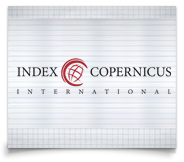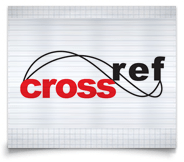Indexing Databases
-
 Index Copernicus International: Index Copernicus International (ICI) is an international, online database and specialized platform for promoting scientific achievements, as well as supporting national and international collaboration between scientists, publishers of scientific journals and scientific entities of user-contributed information, including scientist profiles, as well as of scientific institutions, publications and projects. ICI has several assessment tools to track the impact of scientific works and publications, individual scientists, or research institutions. In addition to the productivity aspects, ICI also offers the traditional abstracting and indexing of scientific publications.
Index Copernicus International: Index Copernicus International (ICI) is an international, online database and specialized platform for promoting scientific achievements, as well as supporting national and international collaboration between scientists, publishers of scientific journals and scientific entities of user-contributed information, including scientist profiles, as well as of scientific institutions, publications and projects. ICI has several assessment tools to track the impact of scientific works and publications, individual scientists, or research institutions. In addition to the productivity aspects, ICI also offers the traditional abstracting and indexing of scientific publications.
-
 Sherpa/Romeo: The indexing platform holds records of 22000 journals. This is a service delivered by Sherpa to display copyright and open access self-archiving policies of academic journals. Based on their archiving policies the data base classifies different journals according to a colour scheme. Authors benefit from it as they get to know whether the concerned journal agrees to provide pre-print or post-print archiving in their copyright transfer contracts.
Sherpa/Romeo: The indexing platform holds records of 22000 journals. This is a service delivered by Sherpa to display copyright and open access self-archiving policies of academic journals. Based on their archiving policies the data base classifies different journals according to a colour scheme. Authors benefit from it as they get to know whether the concerned journal agrees to provide pre-print or post-print archiving in their copyright transfer contracts. -
 Google Scholar: Google scholar helps researchers to search for digital or physical copies of articles. Its indexing services include journal manuscripts, thesis, books and other documents. Google scholar has many features, like "cited by" which provides the abstract of those articles which have cited the article being viewed. Google scholar calculates and provide author's total citation count, h-index and i-10 index.
Google Scholar: Google scholar helps researchers to search for digital or physical copies of articles. Its indexing services include journal manuscripts, thesis, books and other documents. Google scholar has many features, like "cited by" which provides the abstract of those articles which have cited the article being viewed. Google scholar calculates and provide author's total citation count, h-index and i-10 index. -
 Crossref (DOI): Run by the Publishers International Linking Association Inc. is an official Digital Object Identifier (DOI) Registration Agency of the International DOI Foundation. Crossref is a not for profit organization. It doesn't allow to find full text scientific content but it helps in linking distributed content which are hosted on other websites.
Crossref (DOI): Run by the Publishers International Linking Association Inc. is an official Digital Object Identifier (DOI) Registration Agency of the International DOI Foundation. Crossref is a not for profit organization. It doesn't allow to find full text scientific content but it helps in linking distributed content which are hosted on other websites. -
 CiteSeerX: CiteSeer is pioneer amongst the search engines used to find academic research content. It is a public search engine and digital library for scientific and academic papers. It has been part of open access movement. It has the ability to extract data like author, title and other correlated data for purpose of research and analysis. CiteSeer has the feature to provide automatic notification to new citations to a given research article.
CiteSeerX: CiteSeer is pioneer amongst the search engines used to find academic research content. It is a public search engine and digital library for scientific and academic papers. It has been part of open access movement. It has the ability to extract data like author, title and other correlated data for purpose of research and analysis. CiteSeer has the feature to provide automatic notification to new citations to a given research article. -
 CiteFactor: CiteFactor provides its services in the field of journal indexing, research paper indexing, impact factor and citation analysis. Its purpose is to increase the visibility and further simplify the use of open access. Any journal which is indexed in CiteFactor can provide its author with the impact factor calculated by CiteFactor. Journal pages have pointers to web pages of publisher's website which are integrated into CiteFactor stream pages.
CiteFactor: CiteFactor provides its services in the field of journal indexing, research paper indexing, impact factor and citation analysis. Its purpose is to increase the visibility and further simplify the use of open access. Any journal which is indexed in CiteFactor can provide its author with the impact factor calculated by CiteFactor. Journal pages have pointers to web pages of publisher's website which are integrated into CiteFactor stream pages. -
 PubMed Central: Any author who receives funding from any of the funders mentioned in NIHMS list can obtain indexing in PubMed Central through the publisher. The publisher deposits manuscript in Word or PDF form in NIHMS. The author needs to approve the initial deposition and confirm about the funding as per the NIHMS record. Author must have funding from any of the funders, listed in NIHMS record. After that NIHMS converts the submitted manuscript into XML files and thus PMC documents are created. Author receives second notification and must approve to complete the process. After undergoing several other steps the manuscript gets PMCID and then the manuscript is matched to PubMed record.
PubMed Central: Any author who receives funding from any of the funders mentioned in NIHMS list can obtain indexing in PubMed Central through the publisher. The publisher deposits manuscript in Word or PDF form in NIHMS. The author needs to approve the initial deposition and confirm about the funding as per the NIHMS record. Author must have funding from any of the funders, listed in NIHMS record. After that NIHMS converts the submitted manuscript into XML files and thus PMC documents are created. Author receives second notification and must approve to complete the process. After undergoing several other steps the manuscript gets PMCID and then the manuscript is matched to PubMed record. -
 ROAD: ROAD, the Directory of Open Access scholarly Resources, is a service offered by the ISSN International Centre to provide information about the quality and prominence of OA resources and the criteria or indicators the journals meet. The organization provides a single access point to different types of online scholarly resources published worldwide and freely available. ROAD with support of UNESCO, via its Communication and Information Sector, promotes Open Access (OA), with particular emphasis on scientific information (journal articles, conference papers and datasets of various kinds) emanating from publicly funded research. Working with partners, UNESCO works to improve awareness about the benefits of OA among policy makers, researchers and knowledge managers. Through its global network of Field Offices, Institutes and Centers, UNESCO facilitates the development and adoption of OA-enabling policies.
ROAD: ROAD, the Directory of Open Access scholarly Resources, is a service offered by the ISSN International Centre to provide information about the quality and prominence of OA resources and the criteria or indicators the journals meet. The organization provides a single access point to different types of online scholarly resources published worldwide and freely available. ROAD with support of UNESCO, via its Communication and Information Sector, promotes Open Access (OA), with particular emphasis on scientific information (journal articles, conference papers and datasets of various kinds) emanating from publicly funded research. Working with partners, UNESCO works to improve awareness about the benefits of OA among policy makers, researchers and knowledge managers. Through its global network of Field Offices, Institutes and Centers, UNESCO facilitates the development and adoption of OA-enabling policies.
Our journals are also indexed in other platforms like DRJI, Academic keys, Root Indexing, SPARC Indexing, ROAD (Directory of Open Access Scholarly Resources), OAJSE, ISI (International Scientific Indexing), SIS (Scientific Indexing Services), Scholarsteer, Journal Index, InfoBase Index, IJCMJE (International Committee of Medical Journal Editors), I2OR, IP Online Journals and ResearchBib.
Sharing Databases
Peertechz is committed to provide greater visibility to its authors by sharing the website link of their manuscript on different blogs and social media platforms. Promoting the manuscript on blogs, with a summary of research content helps in improving citation for the manuscript. The whole idea behind sharing is to disseminate manuscripts with ease across the global scientific fraternity.
The fourth industrial revolution has taken the academic publishing to a new level with more use of technology on internet. Internet penetration has achieved new milestone as emerging economies like India and South Africa wants their citizen to go digital in every way.
Illustrative videos to explain significance of a particular research is being widely used on social media platform like Facebook and twitter.
We hope that the trends in academic publishing will keep accelerating towards a major technological advancement. This will pave the way for inclusion of technology like virtual reality to present the research work to scientific community.
Other sharing platforms are TrendMD, My Science Work, Mendeley, Live Journal, CrossMark, Academia, Flickr, MathJax, DISQUS, ORCID, PdfSR, iSSUU and Bing, Yahoo and Google.





























 NIH Funded Articles
NIH Funded Articles

